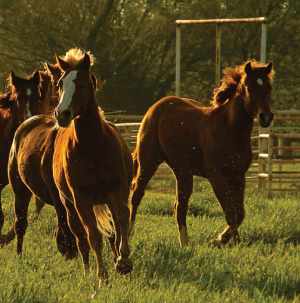The horse started a slow, focused roll. Two-and-a-half minutes later, Scott McCutcheon and Inwhizable were world champions.
Bright lights lined concrete walls of a trail-ride-long tunnel that sloped to the dirt ring in a new bull fighting coliseum in Jerez, Spain. Half way down the ramp, Scott McCutcheon, a six-foot tall Texan from Whitesboro, settled into his saddle and patted the neck of his chestnut colored championship ride, Inwhizable. The pair was part of a Texas team, most of them from Grayson County, who had come to Europe with one goal, to become the first Americans to win gold medals in the World Equestrian Games. Standing still as a Remington bronze, six-year-old Inwhizable knew what was coming. He had just gone through set up, his pre-competition drills. “He was perfectly motionless. I could feel his heart beat. It was a strong, steady, relaxed beat,” McCutcheon said. The pair took in their surroundings as they waited for their turn in the ring.
Inwhizable’s ears moved like tiny radar dishes, forward to catch the sounds of a crowd of more than 20,000, backward to listen to his trainer. He shifted the bit at the end of his silver plated, hand-etched bridle. His coat looked so healthy it glowed.
McCutcheon wore a heavily starched white shirt, jeans creased switchblade sharp, boots, chaps and cowboy hat. He sat back and enjoyed the stadium’s scent. It smelled new: fresh paint, fresh welds and fresh dirt.
A roar of approval for the team that had just finished performing drifted up the tunnel. A voice boomed over the PA. “From the United States, Scott McCutcheon and Inwhizable”.
The rider leaned forward slightly, squeezed his calves along Inwhizable’s flanks, and the horse started a focused stroll into the ring. Two and a half minutes later, after a dizzying series of whirling dervish spins and dirt-spewing sliding stops, Scott McCutcheon and Inwhizable were world champions.
“When it’s over and people are going crazy, you take a peek around and it’s incredible,” he said. “I remember feeling like an Olympic athlete on the podium when they gave us gold medals and played the National Anthem.”
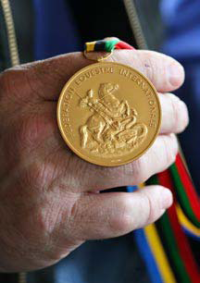
The historic win confirmed what much of the horse world knew: that Texas, especially this part of the Lone Star State, is home to the best Quarter Horses, riders, trainers and equine experts on the planet.
Take a lazy drive on a clear Sunday morning in Grayson County and you may be surprised at what is in your backyard. Tax rolls show more than 100 ranches in the county. They occupy over 4,000 acres, and have a value exceeding 40 million dollars. A few still raise cattle, but most are Quarter Horse spreads. The equine industry is not just a cherry on top of the county’s economic dessert.
In the last ten years or so, it has become the pot roast and veggies.
Scott and Kathy McCutcheon have a 103-acre ranch in Whitesboro where they train Quarter Horses and riders from around the world. Kathy is a blonde with clear blue eyes, a button nose and a handshake that lets you know she is a lady but not a pushover.
She runs the ranch while Scott trains horses and practices for competition. The down-to-earth couple said it is simple why this is prime horse country. “One reason is that in this area there’s about eight inches of sand with a clay base. It’s perfect because it’s easy on the horse’s feet,” Scott said. “The base is hard like a table with sand on top. That’s perfect for our training. The sandy soil is popular with all horse people.”
Around 40 Quarter Horses roam the hills of the McCutcheon place. At the top of their string are world champion Inwhizable and national champion Mega Jac.
Scott, Kathy and their three daughters love what they do, but it is still a business. “I make my living selling horses I train. Going to horse shows is icing on the cake,” Scott said. “Last year I won $50,000. That’s icing. What we have to do is sell horses. The foreign market is tremendous.”
Sales to foreign horse aficionados do more than bolster the McCutcheon Ranch’s black ink; they benefit the entire county. It takes an equine village to care for these horses before they bring in a profit.
“Our place is a working ranch. We have stallions, babies, brood mares,” said Kathy. “We have anywhere from three to five people who work for us. At the shows we have people who brush, saddle, prepare horses so Scott can ride.”
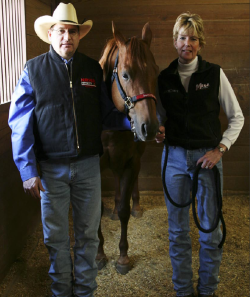
In turn, those people leave a money trail throughout Grayson County, but the monetary boost goes beyond employees. It costs about $150 a month to feed each horse. They need new shoes every six weeks at about $125 a horse. There are fees for vaccinations, supplements like glucosamine for their joints and visits to the vet.
All told, it costs roughly $10,000 to $12,000 a year to care for one horse. Some ranches have hundreds of animals, and most of what it takes to care for them comes from local businesses.
W.D. Ferguson, owner of Dennard’s Farm Supply, has circles under his eyes, attesting to long hours put in due to the booming horse business. He is a bear of a man with salt and pepper hair that curls out from under his black Stetson. He crosses his arms, looks around his 30,000-square-foot store and thinks back.
“Fifteen years ago there were a lot of hobbyists, people doing weekend trail rides. Now it’s a phenomenal business,” he said. His place off US 377 in Whitesboro is testament to that. Ferguson had been in a smaller store more than four decades but decided to move two years ago.
“It’s been busy, busy. We have to be because of overhead. We’re working 30 people where we were working 13 when we were downtown.”
The inventory at Dennard’s is huge, from blankets and bits to tonics and tail treatments. Angie Lamar orders everything. “Our motto is, ‘If we don’t have it, you don’t need it’. I’m not playin’,” she said in a soft drawl. “It’s on our sign!” Lamar, five-feet-two-inches of country attitude with camera-ready dimples, grew up around horses. She has seen the business become ultra-specialized.
Standing behind the oak customer service desk she points to a 50-year-old chalkboard hanging from the ceiling and describes a few feeds from the list of dozens written on it. “We have performance feed for show horses, feed for race horses, we’ve got feed for young horses, feed for old horses, feed for horses that are only ridden once or twice a month,” she said. “You don’t want a horse like that on high performance feed because they’ll be hyper and go through your pasture fence.”
The store may have grown in square footage and types of feed, but Tim Ferguson, W.D.’s oldest son, said it is about more than money. “You want people to feel special, treat them well. We don’t consider customers numbers; we build friendships,” he said.
Dennard’s is not alone in feeling the equestrian economy’s effects. A drive two country songs long takes you to Kyle Tack Shop on US 377 between Whitesboro and Collinsville. Park in the dirt lot, open the front door of the plain white building and draw a breath. The warm smell of leather rolls over you. Images of long rides and rodeos fill your mind. Dozens of custom-made saddles sit in the middle of 4000 square feet waiting for the right rider.
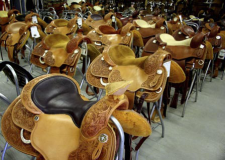
“We sell about 150 custom saddles and 30,000 pairs of bridle reins every year,” said owner Kyle Marshall. “The horse business drives this economy.” Kyle acknowledges the tack business is competitive, but he keeps busy enough that his store hours are written in pencil rather than etched in stone. “Everyone has my cell number,” he said. “I’ll open those doors for customers anytime day or night.” Some of them come a long way, Brazil, Italy, Germany, even Japan.
Despite the sunup to past sundown hours, Marshall would not do anything else. “Other businesses are more profitable, but I like horse people. They’re good people, quick to help out,” he said.
Ten minutes down the road is a shop tucked behind a Paul Bunyan-sized pair of iron and chrome spurs. There you will find another craftsman in love with the cowboy life, custom bit and spur maker Rod Teuscher.
“I’m working on last March’s orders,” he said, wiping his hands on the denim apron hanging from his neck. “I make a thousand bits a year, maybe a hundred pairs of spurs. I start at seven in the morning and leave at nine at night. I love what I do. Every day is Christmas.”
Starting with nothing but a rust-covered iron bar and welder’s torch, he bends and pounds, coaxes and cuts amazing working art forms from metal. “These are ‘dame’s leg’ spurs,” he said holding one of the pair. “The shank looks like a lady’s leg in fishnet stockings and high heeled boots.” He decorated the band (the piece that wraps around the heel) with things that make a young cowboy’s momma nervous. “I made all the vices, a pool cue, dice, cards and whiskey. If you look close, I made the whiskey bottle half empty,” he said, laughing like a kid who had told a bawdy joke.
Another pair of spurs looks as if a snake had slithered onto them. Loose metal on the snake’s tail rattles when the cowboy moseys. Every time the rowel turns, a forked tongue darts in and out of the rattler’s mouth. The spur maker said the design came to him while he slept. Teuscher admits he has some odd dreams.
Whatever his source of inspiration, clients globetrot to buy his wares. From Australia to Austin, they call him. At least one customer came to town and stayed. The man sold his horse ranch in California because where he lived such places were too few and far between. He quickly found a place here. “In California, for somebody to look at his horses, they would fly in, see the horses and leave,” Teuscher said. “Here, it’s like a shopping mall. They look at his horses, look at the neighbors’ horses, and all the neighbors’ customers look at his.” That kind of high dollar immigration into Grayson County is not rare. Of more than 100 ranches on the county tax roll, only 32 have homestead exemptions. That means everyone else lives outside the area.
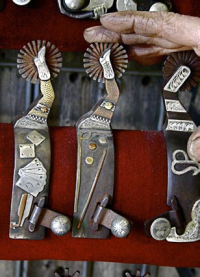
That interest has bucked property values into the stratosphere. RE/MAX, Texoma Realtor Becky Allred knows all about it. “I sold 90 acres a year or so ago, just land, no structures, for approximately $10,000 an acre,” she said. “I told friends years ago to buy! Buy! Buy!”
Allred sounds just like the native Texan she is. “Buy! Buy! Buy!” is “Bah! Bah! Bah!” She is a former hairdresser married to her high school sweetheart and knows Grayson County inside and out. “Buyers from all over fall in love with the town and with the people. We’re close to the freeway, an hour from the airport,” she said.
Prices may seem steep for folks who live here, but not for those moving in. “I worked with one gentleman from Ohio who kept telling me how cheap the land here is,” she said.
Her husband Mike is a renowned custom boot maker. “I’m the best boot maker on Third Street in Whitesboro!” he joked. “I love what I do, wish I could make more, but it takes a week to make a pair.” So he also repairs boots, which takes less time and puts cash in the till.
Ask him about changes the horse industry has brought, and he is pragmatic. “One thing I admire about horse people, when they build their homes and barns and ranches, they’re always appealing to the eye,” he said.
Not too long ago, Mike Allred had a tussle with cancer and the medical bills piled up. His friends and neighbors opened a bank account to help with the expense. When he speaks about horse people, it comes from his heart. “A lot of people donated money. Someone made a sizeable contribution,” he said, eyes a bit misty. The person behind the effort remains anonymous.
That kind of community concern is not unusual. One of Whitesboro’s largest school district fundraisers is the “Kyle Horsing Around Party” held on Pete and Tamra Kyle’s 230-acre Kyle Ranch. Last year, dinner, a band and silent auctions raised more than $30,000 for everything from microscopes to college scholarships.
“It started off when we built the indoor arena and we thought ‘let’s get the neighbors together and have a party’,” Pete said. That was nine years and more than a hundred thousand dollars in donations ago. “You can’t be self absorbed; you have to give back.” Pete is a champion rider, who looks like the lead in a Western movie. Tamra, his wife of nearly 30 years, is a beauty you would gladly give a second glance. (That is if Pete wasn’t standing too close by.)
They train horses and riders for competition, but their place has a 21st century twist. “Versatility is the key for any horse operation. You can board and train and make enough to pay the bills, support families that work for you,” Tamra said, between fielding phone calls, getting wireless internet set up in the barn, and speaking with veterinarian, Doctor Kurt Harris. “You raise horses, sell some and look at other ways to help.” One of those ways is by housing 250 horses for Dr. Harris’ North Texas Embryo Service.
“The purpose is to help a mare that can’t carry a foal because of age or health issues. We take her fertilized egg, put it in another mare, and she can still have a baby,” Harris said.
He also uses the technique for healthy mares so they can have more than one foal a year. (When a champion horse can sell for $250,000, you want the mare that had it to repeat that magic.)
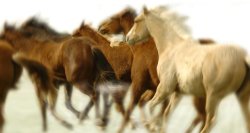 There were 6,000 successful embryonic transplants last year in the United States; 2000 of them were in Grayson County. Interest is worldwide. “We freeze embryos and send them to Europe where they’re implanted,” the veterinarian of 22 years said. “Before, we used to put it in the recipient mare and ship the whole horse.”
There were 6,000 successful embryonic transplants last year in the United States; 2000 of them were in Grayson County. Interest is worldwide. “We freeze embryos and send them to Europe where they’re implanted,” the veterinarian of 22 years said. “Before, we used to put it in the recipient mare and ship the whole horse.”
“Equine reproduction is a very exciting field. They’re doing stuff that will totally blow your mind,” Harris said. “They’re taking embryos, cutting them in four to have four identical foals.” That is right; Doc Harris is talking cloning. Five minutes from the Kyle ranch, researchers at Equine Performance Associates, in conjunction with Texas A&M do just that. The subject makes Dr. Shalyn Bliss’ heart beat just a bit faster.
Wearing jeans, a button down shirt, baseball cap with her curly brown hair pulled back, in, appropriately enough, a pony tail, she looks more like the girl next door than a geneticist. She does her best to dumb down the cloning process for a writer pretending to be technologically astute.
“They take a donor’s egg, use a micro manipulator, insert a needle and take out the DNA,” she said. (This essentially leaves an empty egg.) “They insert DNA from the donor animal, put it in an incubator, and it grows into an embryo and is implanted.” Bliss said nine clones have been bornin Grayson County.“Every time a foal is born I think, ‘Wow, 11 months ago I was holding that little guy in a cup under the microscope.
And who knows, perhaps one of those foals, whose birth could not have been imagined only a few years ago, one day will trot into arena and come home with a championship.
This article appeared in the Spring 2008 issue of Texoma Living!.

